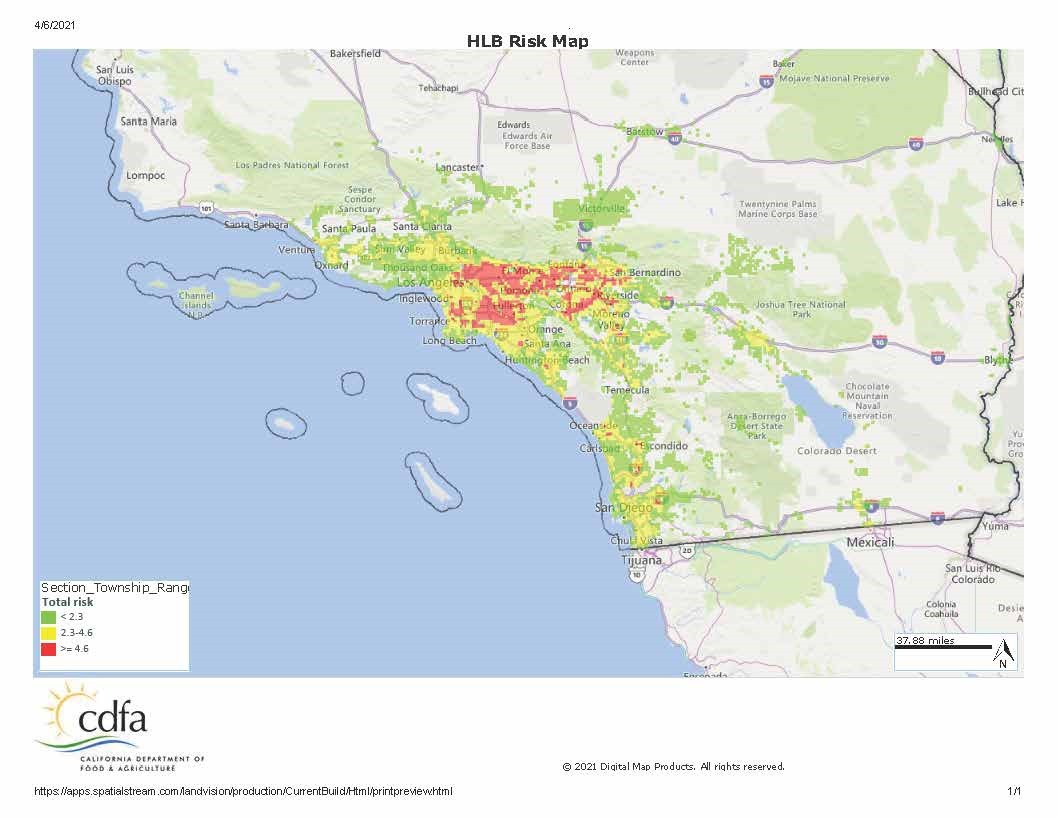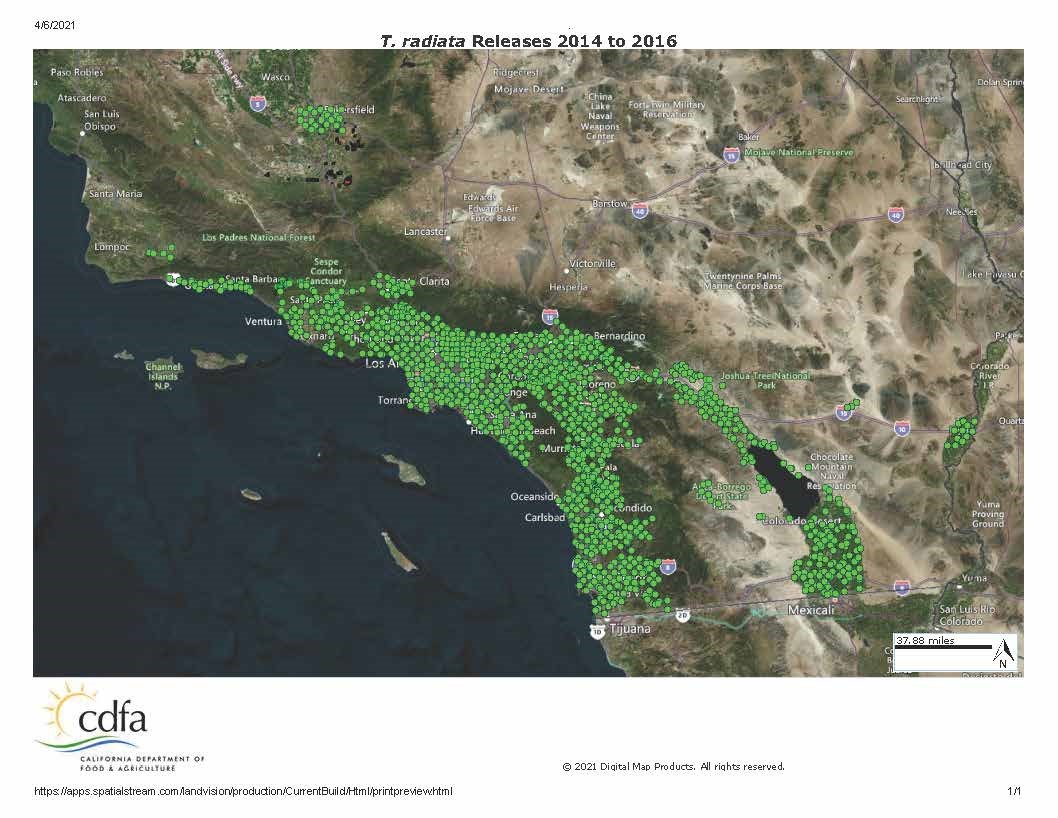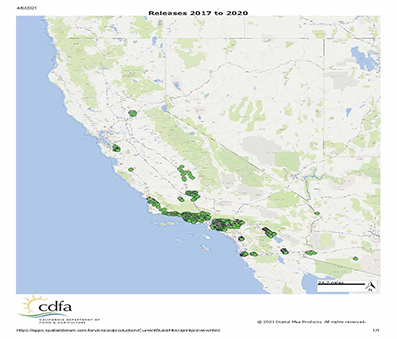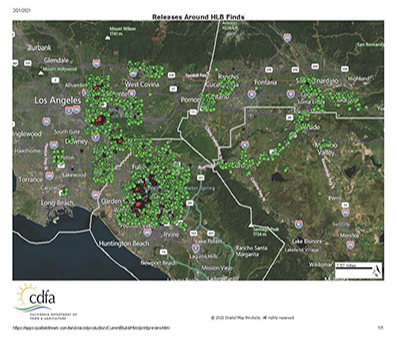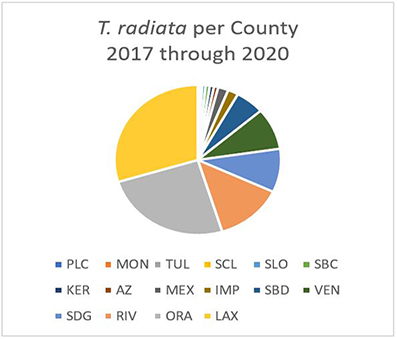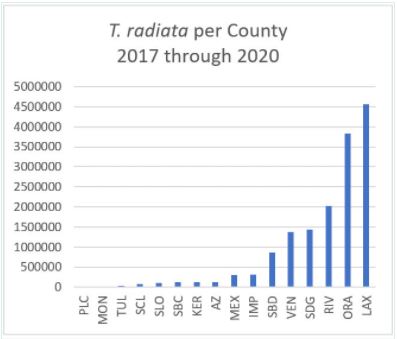Contents
Who are we?
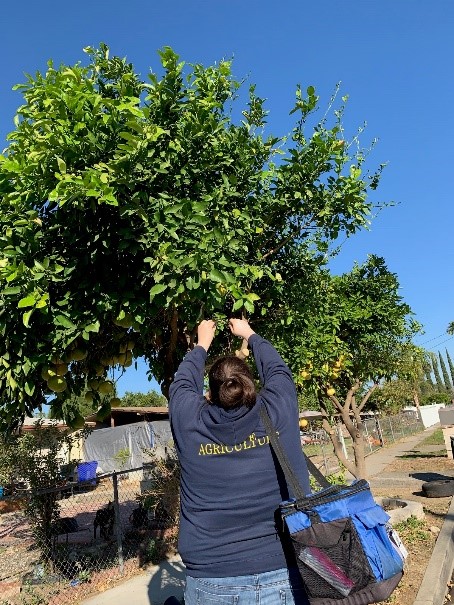
Monitoring ACP Populations.
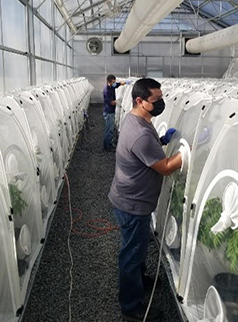
Collecting T. radiata.
We are the Biocontrol Branch of the Citrus Pest and Disease Prevention Division (CPDPD) at the California Department of Food and Agriculture (CDFA). Our operations include rearing and distributing beneficial insects in California, supplying material for release internationally and domestically, and supporting research relating to the Asian citrus psyllid (ACP) and the citrus disease Huanglongbing (HLB). Organizations we collaborate with include: University of California, Riverside (UCR), Cal Poly Pomona, United States Department of Agriculture (USDA), Canine Detection Services, and more.
Mission
Our mission is to protect California citrus, both residential trees and the four-billion-dollar citrus industry with its thousands of associated employees, by managing HLB. HLB is a deadly citrus disease for which there is currently no cure. It has been found in California and threatens the future of our citrus. The vector, ACP, is the primary means by which the disease spreads rapidly from tree to tree. Backyard citrus can harbor ACP and HLB. In Los Angeles alone, it is estimated that 1.2 million residences have citrus. While managing ACP in these areas is critical to slowing the spread of HLB, it is difficult and costly to treat.
To address this challenge, CDFA incorporates biocontrol into its integrated pest management (IPM) strategy, using a highly specific natural enemy of ACP called Tamarixia radiata. The Biocontrol Branch, releases this beneficial insect into the urban environment, reducing populations of the vector (ACP). While pesticide treatments and tree removals are necessary to remove the infection from the area, biocontrol offers affordable, long term management of ACP in backyard citrus. Removing the infection and reducing populations of the psyllid in backyard citrus will help slow the spread of HLB, until a cure is found.
What is Biocontrol?
Biological Control, or Biocontrol, is the use of natural enemies to control pests such as insects, mites, spiders, fungi, algae, and weeds. Categories of natural enemies include predators, parasitoids, pathogens, and competitors and are commonly observed in the yard, for example, as ladybugs or lacewings.
There are three strategies for biological control: classical, conservation, and augmentation. In classical biological control, a pest’s natural enemy, such as a predator or parasitoid, is introduced to a location where it does not already occur to provide control. Appropriate natural enemies are imported and tested before establishing populations. In conservation, pests are managed in a selective manner, conserving the existing natural enemies in an area. In augmentation, large numbers of natural enemies are introduced to provide quick control of existing pests (inundative) or fewer strategically timed releases are made (inoculative) keeping pest populations low.
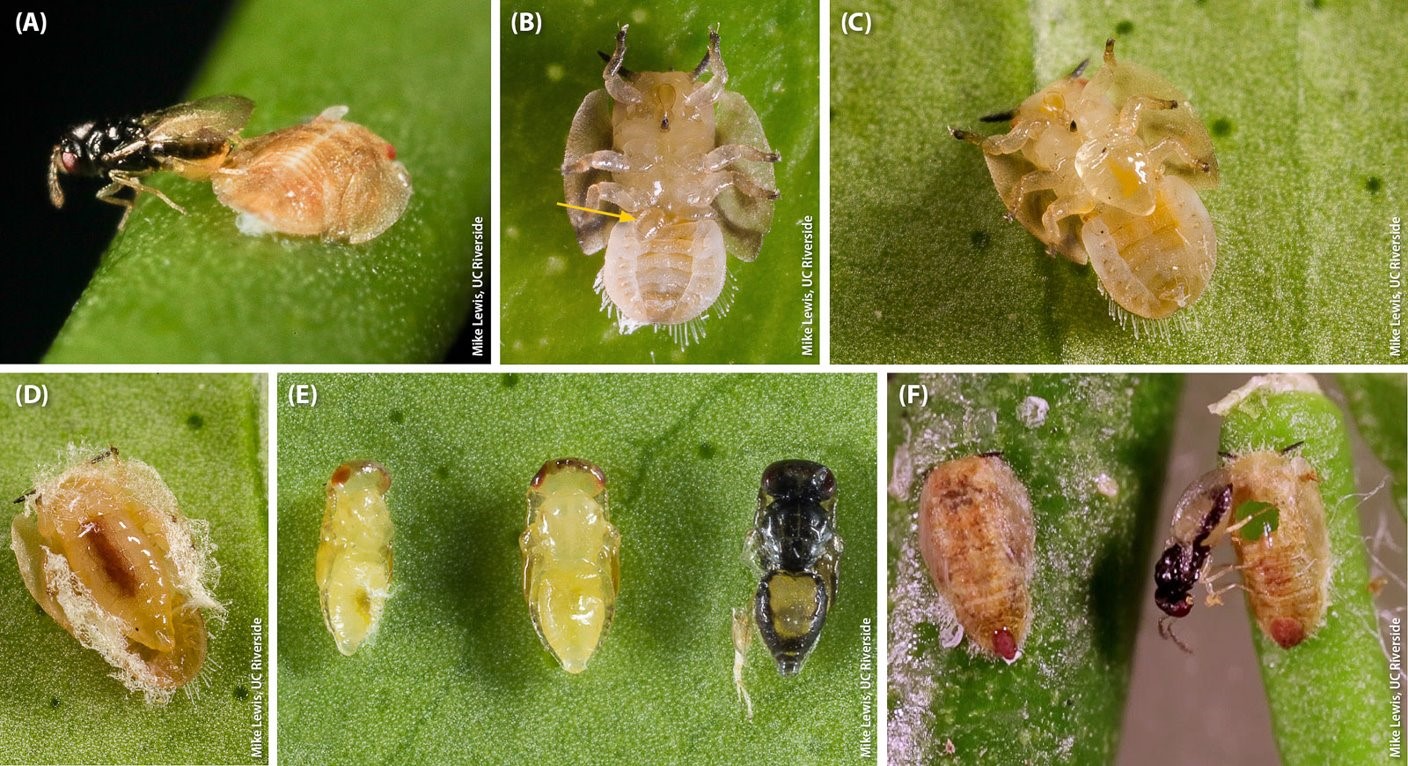
Life stages of T. radiata. Images courtesy of Mike Lewis, UC Riverside.
What is Tamarixia radiata?
T. radiata is a natural enemy of ACP, called a parasitoid. Parasitoids develop on or within another organism, killing it, and are important natural enemies of pests because of their close association. Many parasitoids only prey on one species of pest, minimizing non-target effects. T. radiata specifically targets ACP and was collected from the native range of the psyllid. A female can kill up to 500 ACP nymphs in her lifetime through host feeding and parasitism and has an average lifespan of 24 days. Females feed on young ACP nymphs (1st to 3rd instar) and parasitize older nymphs (4th and 5th instar), by laying a single egg on its hind leg. When the egg hatches, the larva feeds on the nymph, eventually killing it. Once dead, the ACP nymph darkens to a brownish color and becomes a “mummy”. Silk webbing created by T. radiata pupa can be seen around the margins of the nymph, sealing the mummy to the leaf or twig. When ready to emerge, the adult T. radiata chews through the top of the nymph creating an “exit hole”. ACP mummies with exit holes in the anterior region are evidence of successful parasitism. For more information see: http://entnemdept.ufl.edu/creatures/beneficial/wasps/tamarixia_radiata.htm
Why do we need it?
Reducing vector populations is critical to managing the spread of HLB. ACP have high dispersal and reproductive capabilities, contributing to their ability to rapidly spread HLB. Uninfected psyllids are also more attracted to trees infected with HLB, making them more likely to become infected. When ACP arrived in California they escaped from their natural enemy complex, including highly host specific parasitoids like T. radiata, which allowed their populations to explode in California. Biocontrol makes use of the natural enemy complex to reduce ACP populations and thus the transmission of HLB. A successful example of this approach can be found on the tropical island of Reunion where the introduction of T. radiata to control an invasive ACP population has reduced the spread of HLB.
Is it safe?
When T. radiata was first brought to California, an exhaustive study was carried out to evaluate all possible impacts the insect could have in its new environment. This included host range and specificity testing. T. radiata are only able to survive on ACP in California (see https://biocontrol.ucr.edu/asian-citrus-psyllid#tamarixia). T. radiata are safe for humans and pets and has been rigorously tested for its possible impacts on native insects.
Our Strategy
The evolving status of HLB in California requires a management strategy that evolves with it. The Biocontrol Strategy at CDFA has gone through three stages under the growing threat of HLB:
- Classical Biocontrol
- Dispersion
- Augmentative
Classical biocontrol of ACP began in December 2011 when scientists from UCR released T. radiata in California for the first time. In 2012, CDFA collaborated with UCR to introduce over 250,000 parasitoids to California by the end of 2013. Residential citrus in Los Angeles, Orange, San Diego, Riverside, San Bernardino, and Imperial counties were strategically selected and regularly monitored for establishment. From these releases, T. radiata successfully established in California, with parasitism found up to 8 miles away from an initial release point.
As the program grew, CDFA distributed T. radiata every fourth square mile on urban citrus in Southern California. Using a HLB probability map developed by the USDA, more parasitoids were allocated to areas with the highest risk of HLB infection. In this way, over 5 million parasitoids were released across Los Angeles, Orange, San Diego, Imperial, Riverside, San Bernardino, Ventura, and Santa Barbara County from 2014 to 2016 where ACP was established. By 2016, releases extended to Kern County.
Increased HLB finds in 2017 spurred the transition to an augmentative biocontrol strategy, targeting locations from which potentially infected psyllids are most likely to spread. Millions of T. radiata are released per year in California around HLB infections, along major highways, and along the California/Mexico border where citrus is present. HLB infections in Los Angeles, Orange, Riverside, and San Bernardino Counties account for the largest proportion of releases followed by the California-Mexico border and the 15 freeway in San Diego and Imperial County with a small number provided to Mexico, where HLB is present. As a part of the Classical Biocontrol approach, smaller numbers of parasitoids are also introduced to counties where ACP is found, but where HLB has not been detected such as Placer, Santa Clara, Monterey, San Luis Obispo, Tulare, Santa Barbara and Kern County according to risk and availability. Similarly, releases are also made in Arizona to establish populations of T. radiata in neighboring citrus. Over 15 million T. radiata were released from 2017 to the end of 2020.
How you can help
Ants are a mutualist that will protect honeydew producing pests, such as ACP, from predators and parasitoids. Controlling ants with bait traps will help natural enemies, such as T. radiata, forage and kill pests in your yard.
For more information about ACP biological control in California, please visit https://biocontrol.ucr.edu/asian-citrus-psyllid. Up to date information on the release of T. radiata can be found at https://ucanr.edu/sites/ACP/Distribution_of_ACP_in_California/
For more information on biological control in general, please visit https://biocontrol.entomology.cornell.edu/what.php.

